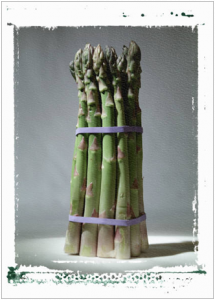After a winter that seemed to never end, I’m ready for some locally grown fresh vegetables! Asparagus is one of the early producing vegetables and it’s now in season. Did you know that May is National Asparagus Month? Here are some things to keep in mind when selecting, storing and preparing asparagus.
 Asparagus has been referred to as a nutritional powerhouse because it is one of the most nutritionally well-balanced vegetables. It provides many health benefits such as antioxidants to help prevent cancer and contains substances that reduce inflammation which can lead to heart disease. Some other nutritional benefits of asparagus are:
Asparagus has been referred to as a nutritional powerhouse because it is one of the most nutritionally well-balanced vegetables. It provides many health benefits such as antioxidants to help prevent cancer and contains substances that reduce inflammation which can lead to heart disease. Some other nutritional benefits of asparagus are:
• Low calorie – one cup cooked, fresh asparagus has approximately 35 calories
• Cholesterol free
• Low sodium
• Excellent source of folate (one serving provides more than half of the recommended daily allowance)
• Good source of vitamins A and C
With all of these good nutritional components, it’s time to select some asparagus to prepare. The following tips can help you select quality asparagus:
• Stalks or spears should be straight and firm
• Thicker stalks of asparagus will be more tender than thin stalks when they are cooked
• A tough woody base is normal but it can be removed prior to cooking
• Avoid asparagus that doesn’t have a compact and pointed tip
Asparagus is highly perishable so it should be chilled quickly and used within one to two days. Do not wash asparagus before storing it since this promote bacterial growth. Wash immediately prior to cooking or eating the asparagus.
Asparagus can be served raw, boiled, steamed or roasted. Cooked asparagus should be tender-crisp and be bright green in color. Over-cooked asparagus will have dull coloring which indicates a loss of flavor and vitamins.
Seasoning asparagus can be fun. Try some different spices such as allspice, dill weed, marjoram, savory or garlic. Add browned, slivered almonds to buttered, cooked asparagus. Or for a more traditional approach, serve with a small amount of butter, salt and pepper.
If you’ve never tried roasting asparagus you’ll be surprised how easy it is to use this method. Wash and trim the asparagus. Then put it on a large rimmed baking sheet and drizzle the spears or stalks with olive oil. Roll the spears/stalks in the oil to fully coat them. Add the seasoning you prefer.
Roasting the asparagus
Preheat the oven to 450 degrees Fahrenheit. Roast medium-thick stalks of asparagus for approximately 15 minutes – turning them after about 10 minutes. For thin stalks, roast them for 15 minutes. Use a fork to test for doneness. The stalks should be browned but not burnt.
There are so many different ways to prepare asparagus that you’re likely to find at least one method you and/or your family will prefer. If you’re looking for other ideas on how to prepare asparagus check out this fact sheet from Ohio State University Extension: http://ohioline.osu.edu/hyg-fact/5000/pdf/5508.pdf
Written by: Treva Williams, Extension Educator, Family and Consumer Sciences, Ohio State University Extension, Scioto County
Reviewed by: Linnette Goard, Field Specialist, Food Safety, Family and Consumer Sciences, Ohio State University Extension.
Resources:
Brahm, Barbara A. Selecting, Storing and Serving Ohio Asparagus, Ohio State University Extension, http://ohioline.osu.edu/hyg-fact/5000/pdf/5508.pdf
Michigan’s Amazing Asparagus, The Michigan Asparagus Advisory Board, http://www.asparagus.org/maab/recipes/Asparagus05Brochure.pdf

